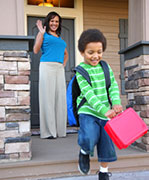
MONDAY, April 7, 2014 (HealthDay News) — Many parents are understandably worried about letting their kids walk or bike to school.
Motor vehicle crashes are the leading cause of death in children aged 2 to 14, and one of five kids killed in a traffic accident in the United States each year was on foot at the time, according to the U.S Centers for Disease Control and Prevention.
Now a new study published online April 7 and in May print issue of Pediatrics suggests that more walking doesn’t necessarily have to mean more accidents for kids.
Instead, researchers say, the likelihood of an accident depends more on the environment kids have to travel through — such as high-traffic areas — and they’re calling on policymakers to do more to make sure kids can safely walk or bike to school.
Dr. Gilbert Liu, a pediatrician at the University of Louisville, and father of four, understands the fear.
“The more that you’re on a busy street, the greater the risk would be of getting hurt crossing an intersection,” said Liu, who was not involved in the new study.
But he says there are also big health benefits to getting kids walking. Kids who walk or bike to school get more physical activity, and they tend to maintain a healthy body weight more easily.
For the study, Canadian researchers fanned out across the city of Toronto. They counted how kids arrived at 118 schools around the city on a single spring day in 2011. They used that number to estimate what proportion of the kids enrolled in the schools actively traveled to school each day.
They then compared those estimates to the number of pedestrian collisions reported within the school boundaries from 2002 to 2011.
Over those nine years, there were 481 collisions within 105 school boundaries — most were minor or resulted in no injury. Thirty were counted as serious, and there was one fatality.
The researchers also recorded features of the “built environment” around the schools, such as how many traffic lights there were, and whether there were “traffic-calming” devices like crossing guards and speed humps.
At first blush, researchers said, the news wasn’t good. The more kids walked or biked to given school, the higher their risk of getting hit by a car.
But the picture changed after they factored in environmental features like crossing guards, speed humps, and traffic lights. Those features were more strongly associated with the risk of pedestrian accidents than the proportion of kids who were walking or biking to school.
At first, those results might seem a little counterintuitive. After all, those are all things that are designed to makes streets safer, not more dangerous. But researchers say those are also things that are markers for busy traffic areas.
“It’s not that the traffic light is where the crash happens. It’s that if you’re in a neighborhood with lots of traffic lights, that’s probably the kind of built environment that’s built for cars rather than for children,” said lead researcher Dr. Andrew Howard, a senior scientist at the Hospital for Sick Children in Toronto.
Liu agreed.
He said it’s a little like finding a large number of fire trucks at a big fire.
“The last thing you’d want to say in a situation like that is ‘well, maybe, if we reduce the number of fire trucks we could reduce the size of the fire,” he said.
Both experts said the real solution is making high-traffic areas around schools safer for kids who travel on foot.
“Making street improvements has been shown to be economically revitalizing. People who live in more walkable environment report more social cohesion and a greater sense of community,” said Liu, who co-wrote a journal commentary on the research.
“When you make a community more walkable, you make it a better place to live overall,” he added.
More information
For more tips on how to walk to school safely, visit the National Center for Safe Routes to School.
Copyright © 2026 HealthDay. All rights reserved.

